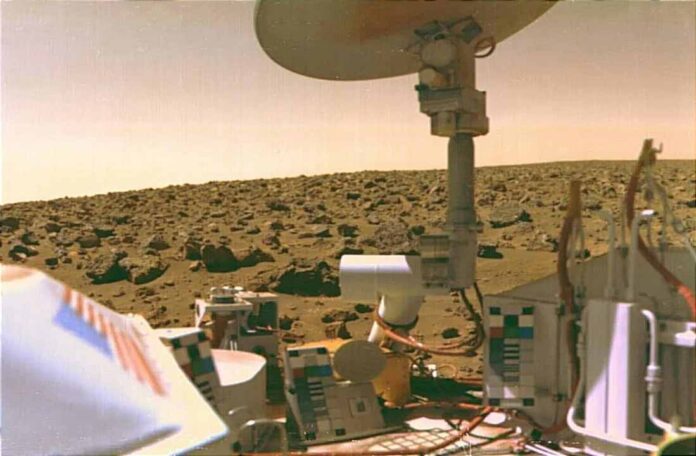Recent claims by a scientist suggest NASA may have discovered and exterminated Martian life almost 50 years ago without realising what it was. However, even specialists can’t agree on whether the latest claims are pure imagination or a fascinating new theory that could explain some mysterious prior trials.
According to a June 27 article by Dirk Schulze-Makuch, an astrobiologist at Technical University Berlin, the Viking landers that NASA sent to Mars in 1976 may have sampled microscopic, dry-resistant lifeforms lurking inside Martian rocks.
The studies conducted by the landers “overwhelmed these potential microbes,” so even if such extreme life forms did and do exist, they may have been eradicated before they were found.
“A suggestion that some people surely will find provocative,” Schulze-Makuch remarked. However, he cautioned that comparable microorganisms do exist on Earth and may potentially exist on the Red Planet.
Viking Observations
Each Viking lander, Viking 1 and Viking 2, conducted four separate experiments on Mars: a GCMS experiment to detect carbon-containing organic compounds; a labelled release experiment to test for metabolism by adding radioactively traced nutrients to the soil; a pyrolytic release experiment to detect carbon fixation by potential photosynthetic organisms; and a gas exchange experiment to determine whether or not Martian soil could support life.
The Viking tests yielded puzzling results that have baffled scientists ever since. Evidence for life on Mars was found in the tests of labelled release and pyrolytic release. Variations in gas concentrations, while subtle, suggested metabolism in both trials.
The GCMS also detected low levels of chlorinated organic chemicals, which were initially attributed to contamination from earth-based cleaning solutions. (Later Mars rovers and landers confirmed the presence of these organic molecules in the Martian environment.)
Most scientists came to the conclusion that the Viking experiments did not find Martian life because the gas exchange experiment, the most critical of the four, yielded a negative result.
However, according to Schulze-Makuch, most of the tests may have yielded inaccurate results since they employed excessive amounts of water. (Water was added to the soil in the labelled release, pyrolytic release, and gas exchange studies.)
Too much of a good thing
“Since Earth is a water planet, it seemed reasonable that adding water might coax life to show itself in the extremely dry Martian environment,” Schulze-Makuch explained. “Perhaps that method was too much of a good thing in retrospect.”
Hygroscopic rocks, which are extremely salty and draw in minute amounts of water from the air, allow extreme bacteria to flourish in extremely dry earth conditions like the Atacama Desert in Chile. Mars has the right kind of rocks, and the red planet has enough moisture to support life, at least in theory. Schulze-Makuch speculated that the bacteria would have been able to take in more moisture and produce some of the chemicals discovered in the labelled release experiment if they also included hydrogen peroxide, a chemical that is compatible with some life forms on Earth.
However, these microorganisms can’t handle a lot of water at once. Extreme floods in the Atacama Desert in 2018 killed up to 85% of native microorganisms that were unable to adapt to the wetter conditions, according to a study published in the journal Scientific Reports.
Adding water to the Viking soil samples could have been like abandoning someone in the middle of the ocean for the bacteria there. They both require water for survival, but too much of the wrong kind can be fatal. Written by Schulze-Makuch.
Cornell University astrobiologist Alberto Fairén, who co-authored the 2018 paper, told Live Science in an email that he “totally agrees” that the addition of water to the Viking experiments could have killed any hygroscopic bacteria present and led to the conflicting results seen by the Viking mission.
Controversial Claims
The possibility that the Viking experiments may have accidentally killed Martian bacteria has been brought up by experts before. In 2018, another group of researchers argued that any bacteria present in the soil samples might have been eliminated due to an unforeseen chemical reaction that occurred when the samples were heated. This group suggests that this may also account for some of the strange experimental findings.
Other experts, however, disagree with Schulze-Makuch and the like and think the Viking results are far clearer. Perchlorate, a chemical used in fireworks, road flares, and explosives and found naturally within some rocks, was detected on Mars in 2007 by NASA’s Phoenix lander, the successor to the Viking landers.
According to Chris McKay, an astrobiologist at NASA’s Ames Research Centre in California, “the Viking dilemma has been resolved” because the presence of perchlorate and its byproducts can adequately explain the gases detected in the original Viking results.
McKay argued that scientists who keep trying to discredit the Landers’ findings are wasting their time. “I disagree with their logic,” he declared. To explain the Viking results, “invoking a strange new type of life is not necessary.”
